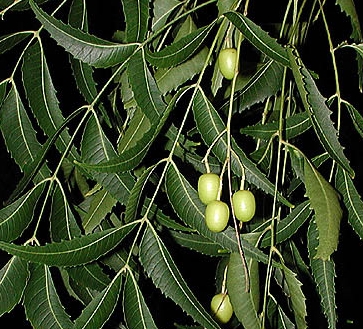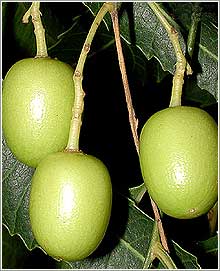NEEM
 
Botanical name : Azadirachta indica A.Juss
Family : Meliaceae
Distribution
Neem is a versatile multipurpose tree native of dry forest areas of India, Pakistan, Sri Lanka, Malaysia, Indonesia, Thailand, Myanmar and Africa. In India it occurs throughout the drier parts including the states of Uttar Pradesh, Bihar, Orissa, Maharastra, Gujrarat, Rajasthan, Karnataka, Andhra Pradesh and Tamil Nadu.
Environmental Requirements
Neem is a sturdy tree and can adapt to a-wide range of climatic, edaphic and topographical conditions.
Climate Temperature
Being a tropical / sub-tropical plant, it is found in areas with annual mean maximum temperature upto32.5 to 42.5°Cand minimum temperature of 4 to 21°C. Temperatures below 4°C and frost are unfavorable.
Rainfall
Neem comes up well in areas with an average annual rainfall of 450 - 1200 mm.
Soil
Neem grows well on almost all kinds of soils which are well drained. It grows well in loamy, clayey and black cotton soil. It also thrives better than other species on dry, stony, clayey and shallow soils. It can also come up on soil, where there is hard calcareous or clay pan just below the soil surface. It does not grow well on sodic soil and grows moderately on alkaline soil. The optimum pH is 6.2 and above and can also grow well at pH 5.0 and helps in increasing the pH through the addition of calcium rich leaf litter. Water logging and poorly drained soils are unsuitable for Neem.
Phenology
Neem is an evergreen tree, but in dry locations, it sheds its leaf during February to March leaves appear during March to April. Flowering varies with climate of the locality. Flower from January to March. Fruit ripen from June to August.
Silvicultural Characters
Light - Neem is a light demander but tolerates fairly heavy shade during the early ye;
Frost - It is frost tender species and cannot withstand excessive cold, especially in se and sapling stages.
Drought - Well extensive root system makes neem drought hardy
Waterlogging - Neem cannot withstand waterlogging
Fire - Fire tender species
Coppice - It can coppice well
Root suckers - Produces root suckers
Pollarding - It can withstand pollarding
Silviculture
Natural regeneration - Though self sown seeds and through seeds from birds dropi neem reproduce naturally. It establishes well in thorny bushes, along field bunds, wire fence "telegraph wires. It requires protection from grazing during early stages. Natural regene from coppice and root suckers' is also common.
Artificial Regeneration
Neem seeds are collected from June to August. Fresh seeds collected should be usi sowing. Fruits on collection should be depulped and shade dried and then treated with fungi like Agrason or Cerason and than used for sowing. Artificial regeneration could be ach though direct sowing or out planting nursery raised seedling.
Direct seeding - This is adopted for raising plantation for fuelwood and for the reclarr of wastelands. This could be done through (i) dibbling in bushes, (it) broadcasting, (ii) sow lines, (iv) sowing on mounds or ridges, (v) sowing in trenches.
Nursery Techniques
Seeds of neem can be directly dibbled into polybags of size 20 x 10 cm or 20 x 15 cm with soil, sand and FYM in the ratio of 1:1:1 or 2:1:1. Soil with high clay content or pH 8 and £ should be avoided. Fresh seeds should be graded and large size seeds are sown in polybc the rate of two seeds per bag. After germination leaving the healthy one the other one is rem Excess healthy seedlings can be used for pricking in containers where both the seeds have to germinate. This will ensure uniform size seedlings in the containers. Normally, neem seec do not require shade except, during pricking out stage. Shifting of polybags once in a montl weeding helps to obtain healthy seedling. In frosty locality, protection by raising temporary pa have to be taken up. The bed should be watered twice a day till germination and after germir once a day and after three months the seedlings are watered at temporary wilting for hardi them in the nursery. Seeds with poor germination, could be sown in the primary mother beds at optimum de cm to 2 cm. The seeds are sown by drills 15 cm apart. After germination, at 30 - 40 days the be pulled out and pricked into polybags as above. They can also be kept in the nursery for 1: months and than pulled out for preparing stumps (5 cm shoot, 22 cm root, 1 - 2 cm collar thickness
Planting
In dry localities pits of 45 cm3 and in moist locality pits of 30 cm3 are dug and kept reat planting. Seedling of 6 -12 month old are outplanted into the above pits during the rainy se; Pits can be filled with native soil along with 5 kg FYM and 25 to 50 g of DAP at planting for < establishment and growth. Application of Bursbon in the planting pits will ward of any insect or termite attack during the period of drought. The spacing normally applied for neem is 5 x 5 m or 10 x 10 m. wider spacing is recommended for agroforestry practices.
Maintenance and after Care
Although neem requires less care during the initial stages especially in dry localities watering and weeding are very essential during the first two years for proper establishment and growth.
Watering
Pot watering once in 10 days will help the tree to tide away the drought period. In saline soils watering during summer and periods of drought is necessary. Mulching around the tree basins with pebbles or available mulch in that area will help in conserving moisture.
Tending Operation
Young seedlings should be free from weeds for early establishment and growth. Weeding helps to conserve moisture and nutrients in the soil for the tree to take up for its growth. Drawing of tractor drawn tillers in between trees will help to control weeds and conserve moisture. Weedings also help in loosening the soil for better aeration and root growth. In the naturally raised plantation thinning has to be done at the end of first year to space the seedling apart for initial growth and established. At the end of 2 - 3 year the trees are spaced at 3x3mor5x5m depending on the locality. In the artificially raised plantation at the end of 5th year selective thinning can be taken up to cull out inferior trees and space the good trees at 10 x 10m spacing.
Yield
Neem is grown for its seeds and timber. The tree starts fruits from the 4-5th year and steady yield from the 10th year. Each tree at this age can yield 20-25 kg of fruits/ tree. The ratio of seed to pulp is about 1:2. The rotation age for timber is 35 - 40 years and for fuelwood is about 8 years. The timber yield is about 108 -137 m3/ha.
Uses
Neem has multiple uses. The wood is used as timber for construction, furniture, carts, axles, yokes, boats, .etc. and also as a fuelwood. Neem leaves are good fodder for sheeps and camels with a crude protein of 12 -18%. Neem seed yields 20 - 30% oil content used in pharmaceuticals preparation. Neem oil yields azadirachtin which is used as insect repellent. Neem bark yield 12 -14% tannin. Neem cake is an excellent organic fertilizer. |


